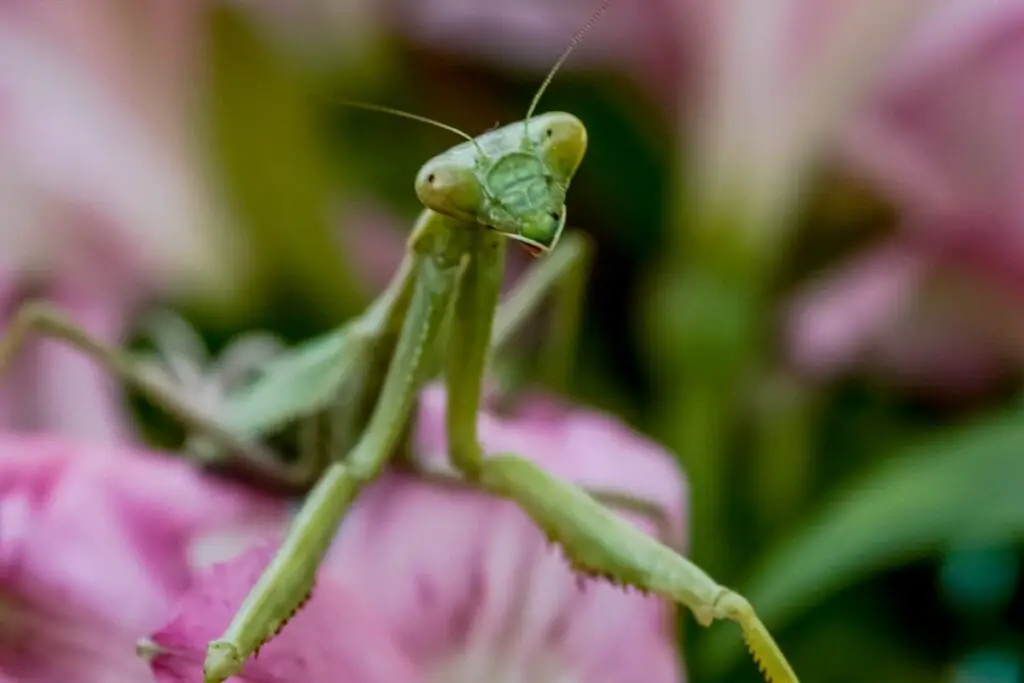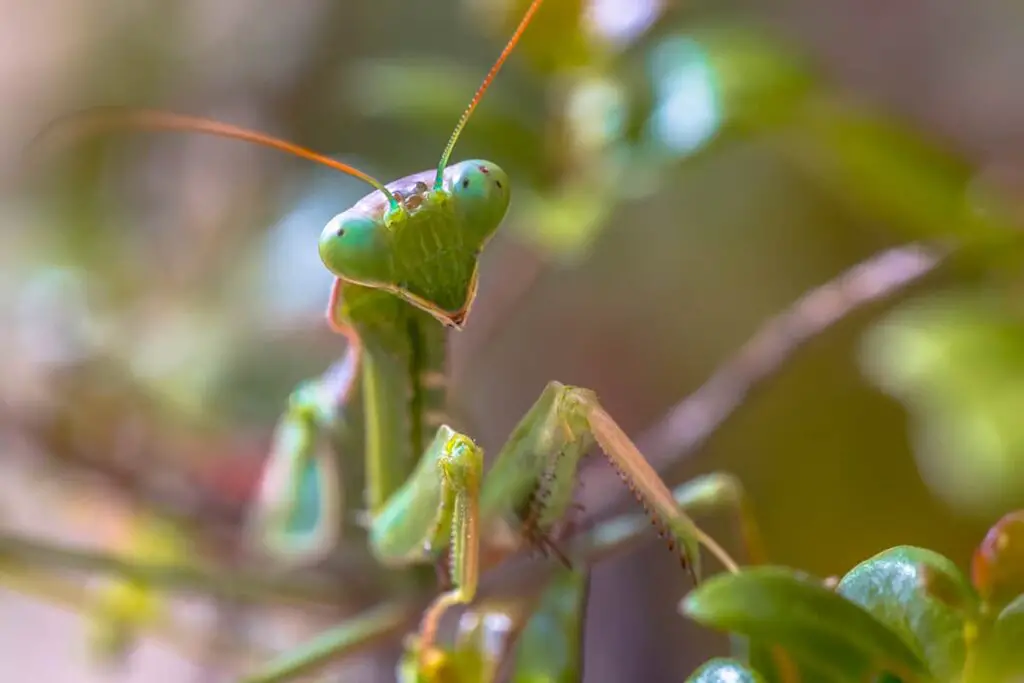Creating a comfortable living space for a praying mantis isn’t just a nice thing to do; it’s essential for their health and well-being. Just like you have preferences for your home’s temperature, praying mantises also require specific temperature ranges to thrive. Knowing these requirements can make all the difference in nurturing a healthy mantis.
For your praying mantis, the habitat’s temperature is more than a matter of comfort—it’s crucial for their physiological processes. Each species of mantis has adapted to specific climate conditions in their natural habitat, whether that’s a cool mountaintop or a humid tropical forest. By mirroring these conditions as closely as possible, you’re providing your mantis with the right environment to regulate its body temperature, digest food properly, and grow healthily.
Maintaining the optimal temperature in the habitat not only ensures your mantis will be active and able to hunt but also supports critical life stages such as molting. A temperature gradient within the habitat can be particularly beneficial, giving your mantis the choice to move to warmer or cooler areas as needed to regulate its body temperature. Remember, the goal is to replicate the varied conditions they might encounter in the wild, providing a comfortable and stimulating home.
Understanding Mantis Species
When setting up a habitat for your mantis, it’s crucial to understand that different species have distinct temperature preferences aligned with their natural environments.
Species-Specific Temperature Preferences
Tropical Species: For mantises hailing from tropical climates, maintaining a high relative humidity (rh) of 70 – 100% is necessary, along with warmer temperatures. These conditions mimic their natural, humid habitats. For instance, some species thrive best when the habitat’s temperature is kept between 24-30°C (75-86°F).
Temperate Species: In contrast, mantises from temperate regions require a medium rh of 50 – 70% and cooler temperatures that reflect the milder climates they originated from. Temperatures for these species are often optimal at a range of 18-24°C (64-75°F).
Desert Species: These mantises are adapted to low rh conditions of 30 – 50% and can tolerate higher temperatures, often requiring conditions up to 30-40°C (86-104°F) during the day, with a noticeable temperature drop at night. Temperature preferences can vary, but a temperature gradient within the terrarium is important so they can self-regulate.
Geographic Distribution
Each species of praying mantis is adapted to the climate of its geographic origin.
- African Species: Often require warm temperatures all year round.
- Asian Species: May need higher humidity levels due to coming from rainforest environments.
- European and North American Species: These are generally more cold-tolerant and can survive lower temperatures, especially during their dormant overwintering stages.
Understanding the specific climate needs based on the geographic distribution of your mantis species is key to successfully replicating their natural habitat and ensuring their well-being.
Creating the Optimal Habitat
Creating an optimal habitat for your mantis involves precise control of temperature and careful selection of design elements and accessories to mimic their natural environment.
Temperature Control
Your mantis’s habitat should have a consistent temperature between 75°F and 85°F (24°C and 29°C). Achieving this is crucial as temperature plays a key role in their health and behavior. Use a reliable thermostat to monitor the conditions within the habitat. An adequate temperature range ensures your mantis can thrive.
Habitat Design and Accessories
Design: Select a habitat that allows for proper ventilation and vertical space for climbing. A combination of materials and lid choices can greatly affect the quality of life for your mantis.
Accessories:
- Substrate: Opt for a natural substrate that retains moisture well without getting soggy.
- Climbing Structures: Provide sticks, branches, or mesh that mimic their natural climbing surfaces.
- Ventilation: Ensure there is sufficient air flow, but not so much as to dry out the enclosure or create harmful drafts.
Monitoring and Maintenance
Keeping your praying mantis happy and healthy requires consistent monitoring and maintenance of its habitat, particularly the temperature and cleanliness.
Temperature Monitoring
To ensure your mantis thrives, you need to maintain a temperature gradient within the terrarium, allowing your pet to choose its preferred spot. Glass tanks are excellent for retaining heat, but you should monitor the temperature with a reliable thermometer. Most mantis species prefer a temperature range between 75°F and 85°F (24°C and 29°C). Regularly checking the temperature at different points of the enclosure is essential for your mantis’s well-being.
Habitat Cleanliness
Your mantis’s home should be kept clean to prevent the growth of mold and bacteria. Routine removal of waste and leftover food is vital. Creating a suitable substrate can help maintain cleanliness and mimic the natural environment. Consider cleaning the enclosure thoroughly every few weeks to ensure a healthy habitat for your mantis.
Frequently Asked Questions
When caring for a praying mantis, achieving the correct temperature is crucial for their health and wellbeing. Here are some specific answers to commonly asked questions to help you maintain a perfect living environment for your mantis.
What temperature should a praying mantis habitat be maintained at for optimal health?
Your praying mantis habitat should generally be within a range of 24 to 30 degrees Celsius (75-86 degrees Fahrenheit). Consistent temperatures within this range can support healthy growth and metabolic processes.
How can you create a warm environment for a praying mantis during winter months?
During winter, use a heating lamp or a heat mat to maintain the adequate temperature inside the mantis enclosure. Monitoring with a thermostat will help to ensure that it remains within the desired range.
What is the ideal temperature range for mantis enclosures in Celsius?
The ideal temperature range for a mantis enclosure is typically between 24 to 30 degrees Celsius. Some variations may apply depending on the specific species of mantis, but this range is generally suitable for many common species.
At what temperature do praying mantises typically perish?
Praying mantises can perish if exposed to temperatures below 4 degrees Celsius (39.2 degrees Fahrenheit) for prolonged periods. It’s important to avoid these low temperatures to prevent harm to your mantis.
What are the best methods to regulate heat in a praying mantis habitat?
Using a thermostat-controlled heat source such as a heat lamp or a heat mat is effective. Always have a temperature gradient, by heating one end of the enclosure, to allow your mantis to regulate its body temperature by moving within the habitat.
How to ensure a warm and suitable climate for mantises in captivity?
Ensure you have accurate temperature control by regularly checking with a thermometer. Adequate ventilation is also key to prevent overheating, and a humidity level appropriate for your mantis species should be maintained in tandem with the temperature.
Driven by a passion for those tiny creatures that rule our world, we at Bug Domain strive to be your go-to resource for information on insects.



